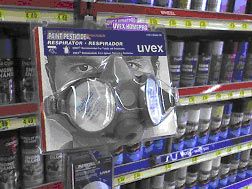With the increasing availability of grant money and heightened awareness of personal protective equipment, you may be considering getting your own gas mask. The number and type offered can be bewildering. Let me trim the weeds for you a bit and be your guide!
 Figure 1 - Disposable respirator. |
First off, lets’ look at what you don’t want. Disposable respirators, as shown in figure one, arguably do have their place. These can be useful in limited situations, such as in post-bombing rescue and recovery efforts after the scene has been characterized by a qualified technician. Even then, I would only recommend using one in conjunction with a decent set of goggles, and only a mask that is N95 rated. N95 masks seal better to the face, and offer improved particulate filtering capabilities. (The type in the picture, by the way, is NOT a N95 mask).
N95 style masks are more expensive, and while there is an argument that any mask in some situations are better than none, skimping a few pennies now will hurt you later.
Note that I say ‘in some situations’. I can’t recommend those masks for any other kind of use, because they can NOT filter the overwhelming majority of WMD agents, and a mask that hangs on your face with a string or two rubber bands will never be able to seal well enough.
For those reasons, you will probably never hear me recommend any of the escape masks, regardless of who certifies them. First, most are snake oil. Prior to 9/11, you saw these things being hawked as fire escape masks. Now they are ALL over the net as being effective protection against WMD agents. Think about economy of scale. Do you think that the Department of Defense wouldn’t rather issue a $50 dollar pocket-size mask instead of a $200 dollar bulky one? Also, look at their construction. The best ones are basically a plastic bag glued to a real mask filter with a scuba mouthpiece. I think I even saw one with a nose pincher.
There is only one good use for an escape mask, and that is this: shove a dozen in your real mask pouch. Hand these out to the worried well so they won’t try to yank yours off at the scene.
Another mask style that is useless for you is the half-face masks that look like a protective cup with two filters on it. You can find these at many home improvement stores, a shelf or two above the disposable ones.
|
|
Yes, they will seal a hundred times better (not really) than the disposable ones, but they don’t make a CBRNE filter for these. And, again, there is no ocular protection. You may not breathe the agent in, but if you get it in your eyes, you still got dosed. For the added cost, they just don’t have any more benefit than the disposable ones.
The last kind of mask you would just be wasting your money on (and gambling your life on), are military surplus masks. These things come from the governments of various countries in two ways; one – shrinkwrapped on a pallet marked “unserviceable”, or two – stolen. Either way, you literally are betting your life on a device with an unknown history. Dryrotting, failing seals, pinholes, and lack of replacement parts and new filters are just a few things off the top of my head. That old M17, or maybe even a Russian aardvark canister mask *might* work against tear gas. If it doesn’t, you’ll live. You actually get in a WMD situation, you might not.
Oh – industrial hygiene masks. These can be very, very good for specific toxic agents. You might even get a set of filters that will work. The same general issues for military masks apply here, too. And, for the purchase price of a new one, you can get a mask that is application-specific for you.
Ok, so what does this leave you?
There are three that I can recommend without reservation. Yes, they are expensive. They are bulky, hot, and will give you the urge to itch your nose. But, they will protect you. They are current, from reputable manufacturers, and use NATO – standard filters.
The newest is the FM-12 from Avon, the next is the MSA Millenium, and the third is the FR-40 from 3M.
Hopefully, you’ve picked up a little on what to pick. In future columns, I hope to cover the masks in more detail.
Until next time,
-Shawn



